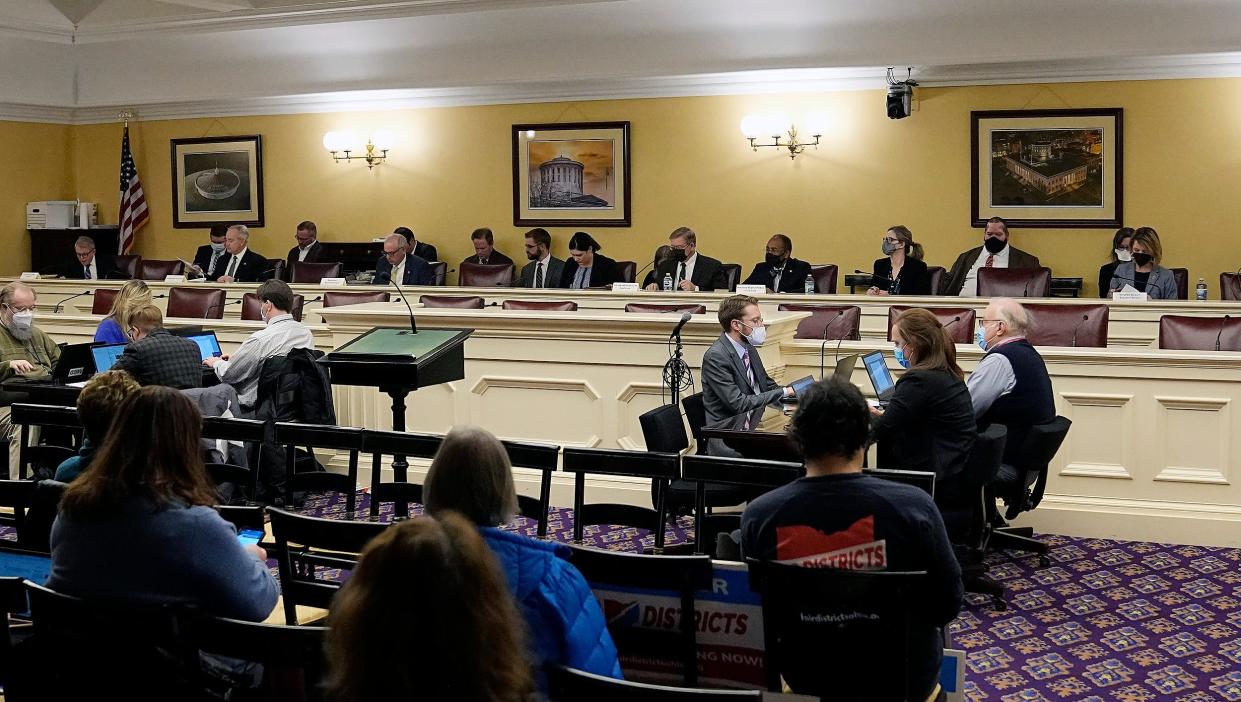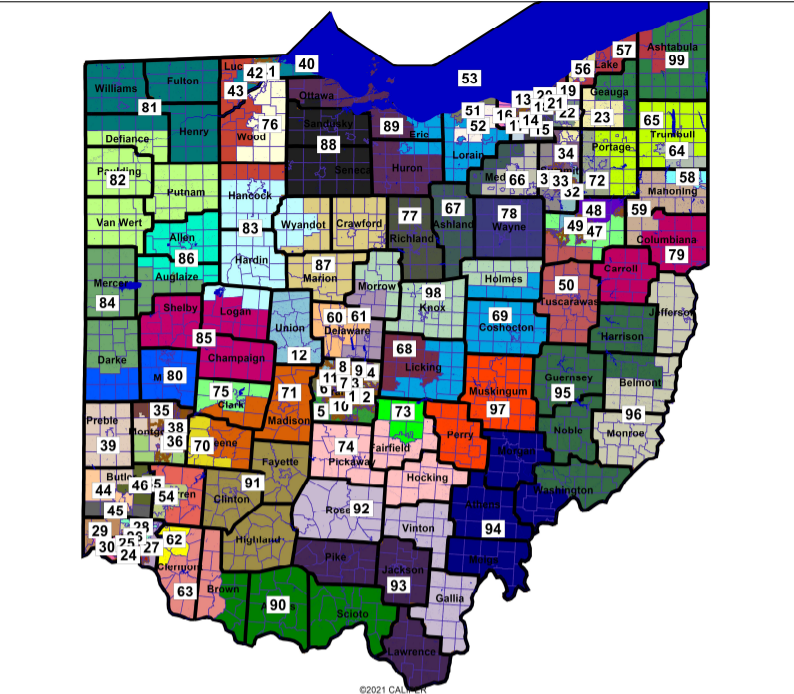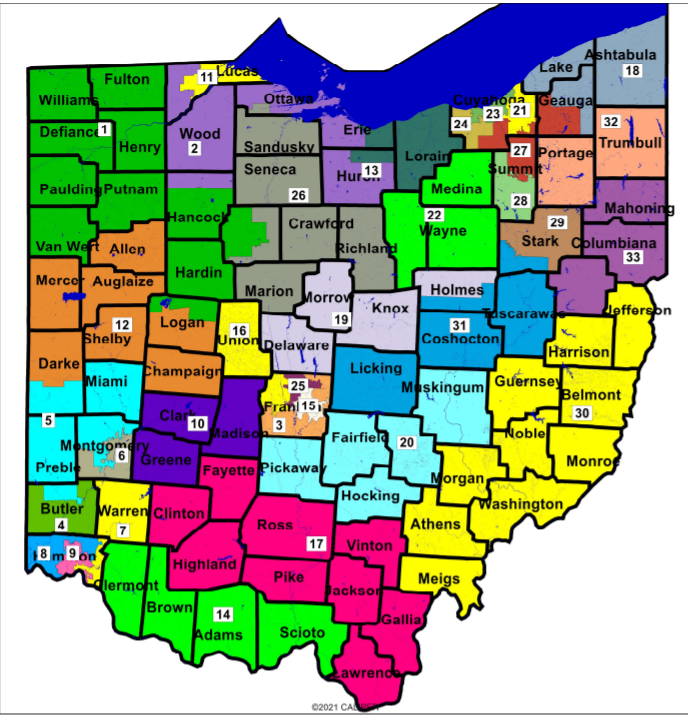Ohio Redistricting Commission passes new 4-year maps for legislative districts, Supreme Court to review

Republican members of the Ohio Redistricting Commission once again approved state House and Senate districts over the objections of Democrats.
The approved maps – which give Republicans a 57-42 advantage in the House and 20-13 advantage in the Senate – now face scrutiny from the Ohio Supreme Court, which recently rejected maps that could have given the GOP five more House and three more Senate seats.
The maps passed with a 5-2 vote along party lines. Because the plan did not receive bipartisan support, it lasts four years instead of 10.


See the plans for the House and Senate.
Democrats say the maps fall short of what the court ordered: maps that match the statewide voting preferences of Ohio voters, about 54% of whom picked GOP candidates and about 46% selected Democratic ones over the past decade.
"It is shameful that we are here again, adopting yet another unconstitutional map in direct contradiction to the Ohio Supreme Court," said House Minority Leader-elect Allison Russo, D-Upper Arlington. "I've felt a little bit like I am a mom with my two teenagers when I ask them to fold and put away the laundry and they simply have stuffed it in their drawers and called the job done."
Republicans, Democrats disagree on 'proportionality'
Republicans contended that perfectly proportional maps weren’t possible without violating other voter-approved changes to the Ohio Constitution, such as keeping districts compact and avoiding splitting municipalities. GOP members of the commission rejected Democratic-drawn maps that gave Republicans a 54-45 advantage in the House and an 18-15 advantage in the Senate.
See the Democratic maps here for House and Senate.
“There are clear violations in here that are not easily fixed,” said Senate President Matt Huffman, R-Lima, after presenting several large versions of House and Senate districts on easels.
Gov. Mike DeWine said he never saw a map that hit Ohio's statewide voting preferences while also complying with other constitutional requirements. "I can't say it's impossible. Maybe there's a map out there, but we didn't see one," he said.
Democrats contended that Republicans did the bare minimum to draw districts that comply with the court order, crafting 12 districts within 1 percentage point for Democrats and no similar districts for Republicans.
Republican Senate staffer Ray DiRossi said that was the product of a court-imposed time crunch.
“When you finally get over the hurdle to go under 50 and everything else balances and everything else matches, I move on to another district," DiRossi said.
Once again, the mapmaking process was mired in miscommunication and conducted largely outside of the public's view. Sen. Vernon Sykes, D-Akron, suggested tackling the map region by region, but ultimately Republicans and Democrats presented separate, statewide maps.
"I think there's a question about whether or not partisan officials, particularly legislators, crafting their own districts, it's questionable how much objectivity they can actually have," Sykes said.
Now, the maps are in the hands of the Ohio Supreme Court, which must decide whether mapmakers did enough to comply with anti-gerrymandering provisions in the Ohio Constitution approved overwhelmingly by voters in 2015. Once again, all eyes will be on Ohio Supreme Court Chief Justice Maureen O'Connor, who wielded the deciding vote last time.
How the maps treat Ohio's cities
Compared to the rejected maps in Franklin County, the new House plan shifts a Republican district in the southwestern part of the county into a slightly Democratic one by centering it more on Grove City. The county's sole Republican, Rep. Laura Lanese, lives in Grove City.
The new map also makes a Senate seat extending from Dublin to Union County slightly Democratic. But Democratic Rep. Beth Liston's Dublin seat will lean more Republican.
In Hamilton County, mapmakers crafted a House district that leans Democratic along the eastern border of the county, dipping into Mount Lookout and Walnut Hills. Republican Rep. Tom Brinkman, who currently represents that area, is term-limited.
Hamilton County will continue to have two Republican Senate districts and one Democratic one despite efforts from Democrats to craft a second favorable district there.
In Summit County, Republican mapmakers drew five House seats that lean Democratic but only one – centered in Akron – does so by more than a percentage point, making them highly competitive. The rejected map had a Republican House district that snaked along the western side of the county.
What happens next
Those who brought lawsuits against the rejected maps have three days to raise any objections. Advocates for redistricting reform expressed frustration and disappointment with Saturday's results.
"It's déjà vu all over again," said Catherine Turcer, executive director of Common Cause Ohio.
Any delays could threaten the deadline for candidates to file paperwork in legislative races, which is currently set for Feb. 2.
Jessie Balmert is a reporter for the USA TODAY Network Ohio Bureau, which serves the Akron Beacon Journal, Cincinnati Enquirer, Columbus Dispatch and 18 other affiliated news organizations across Ohio.
This article originally appeared on The Columbus Dispatch: Ohio redistricting: Commission passes new, 4-year maps, Court to review

